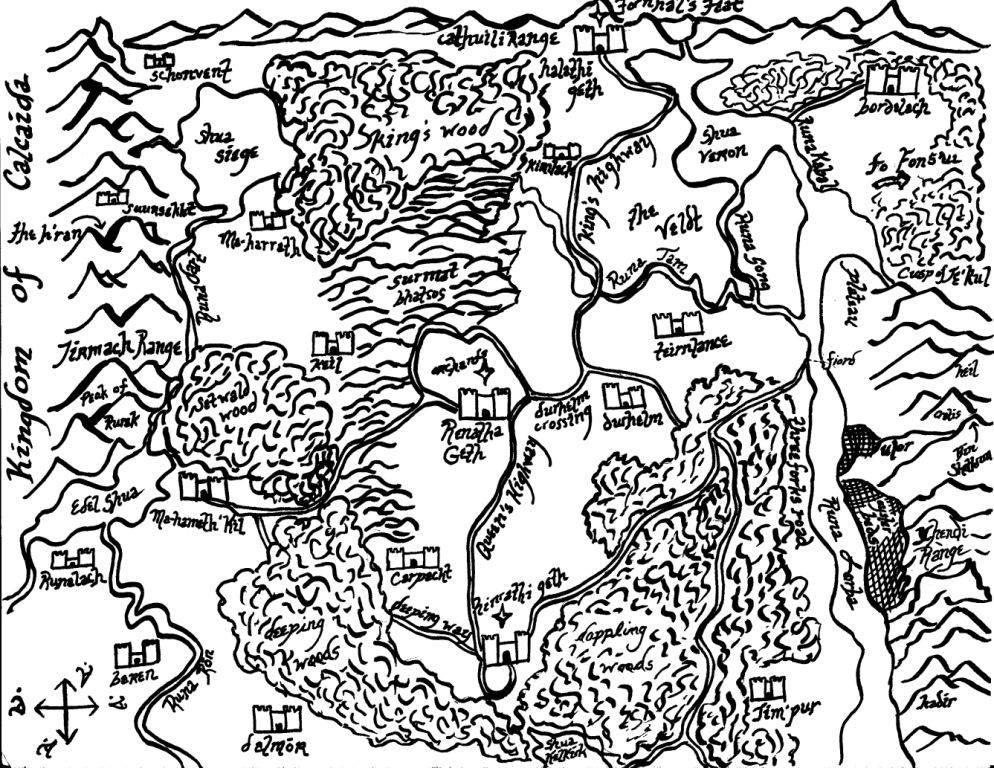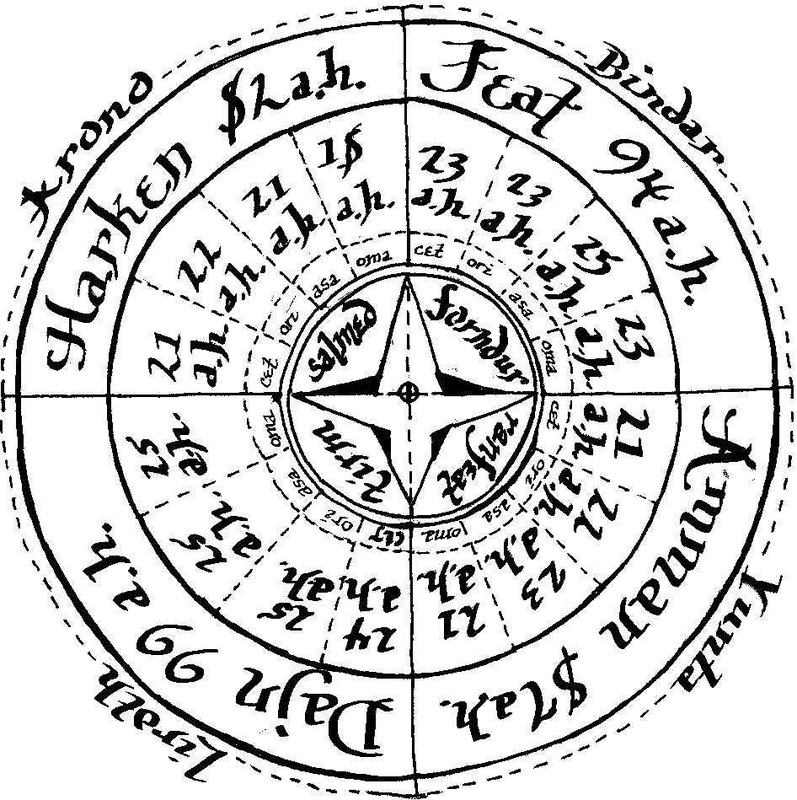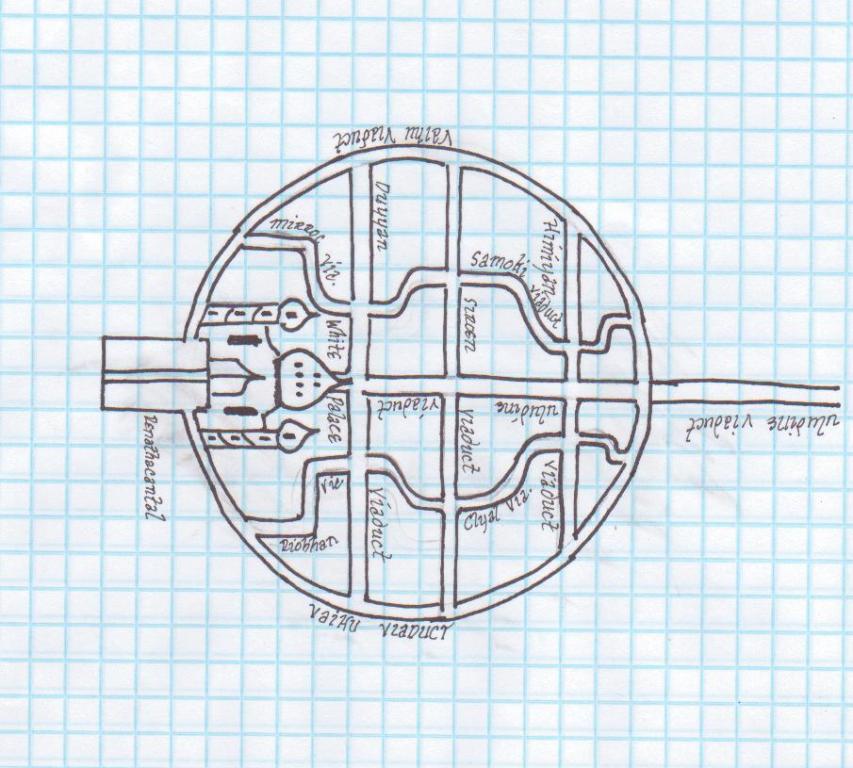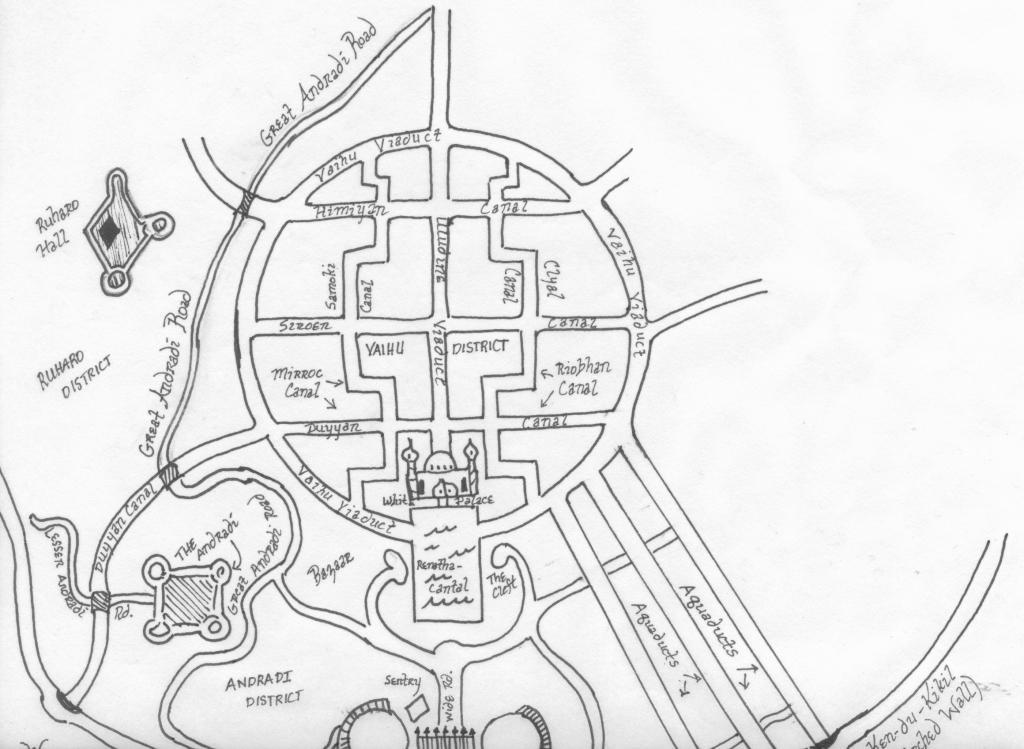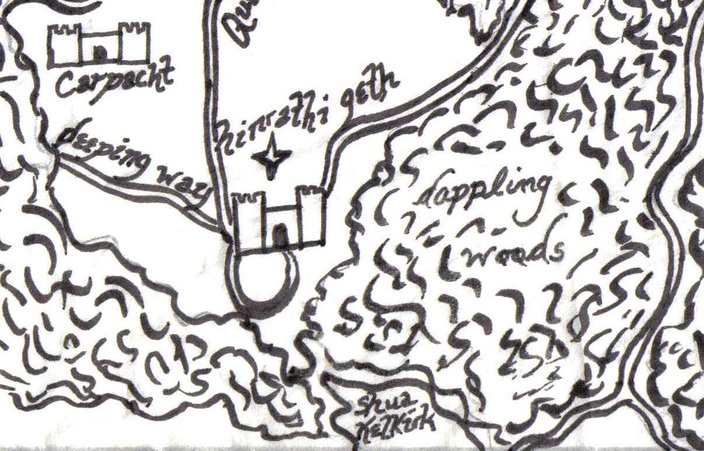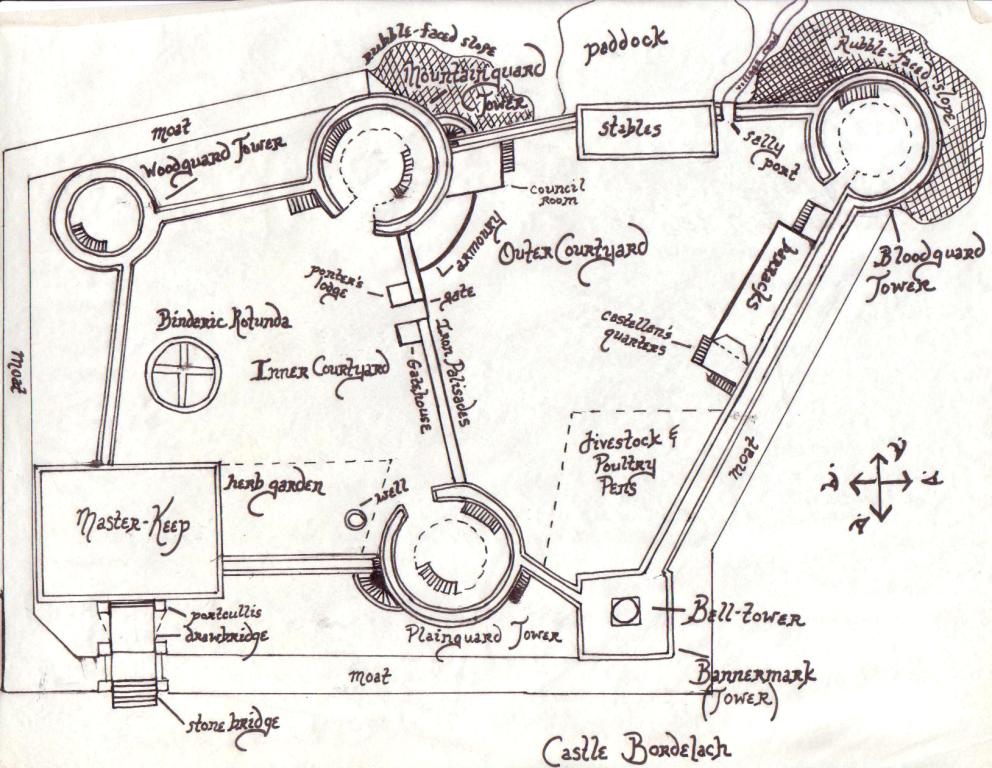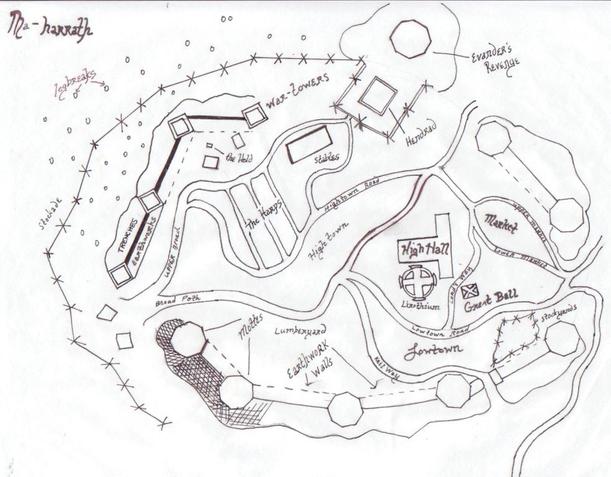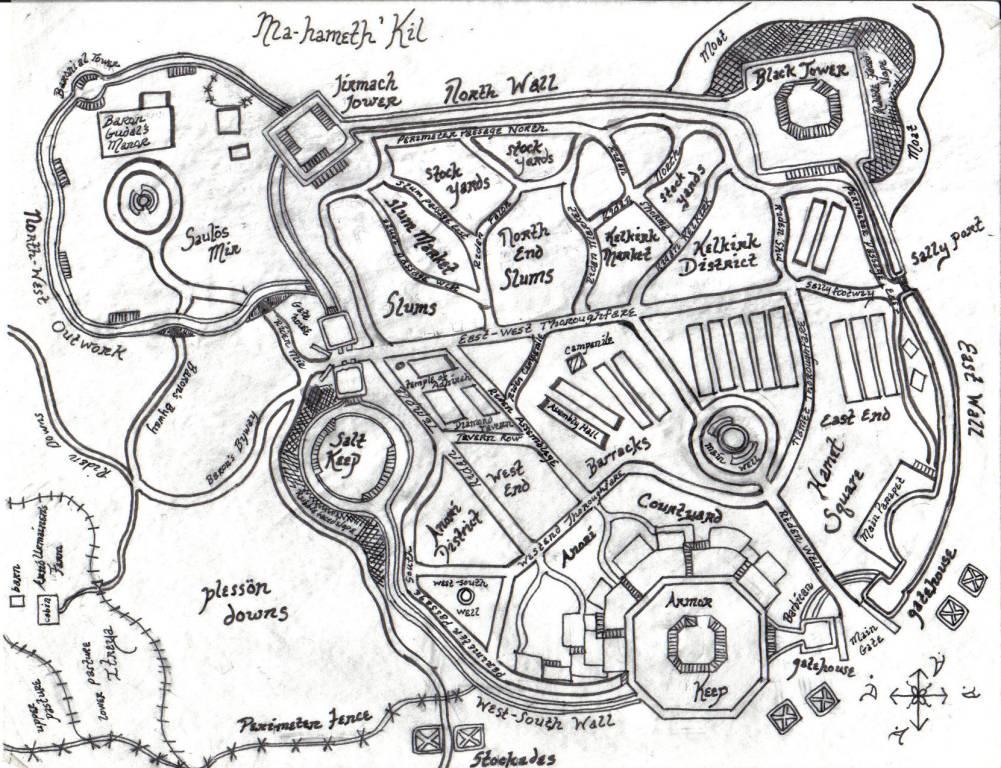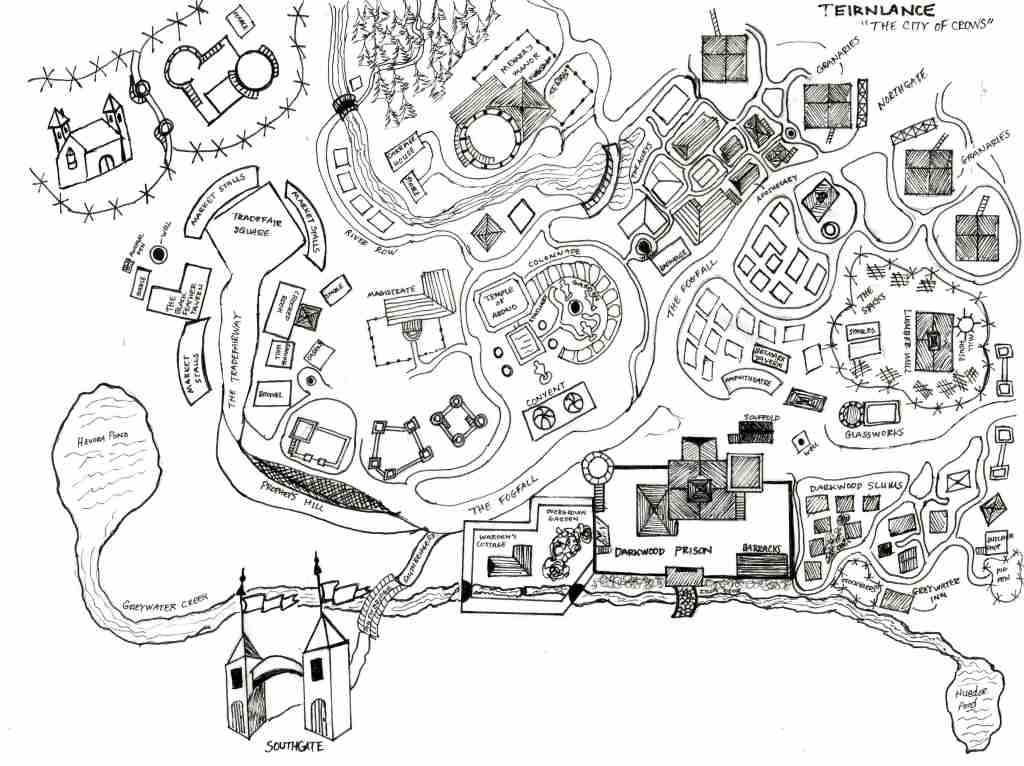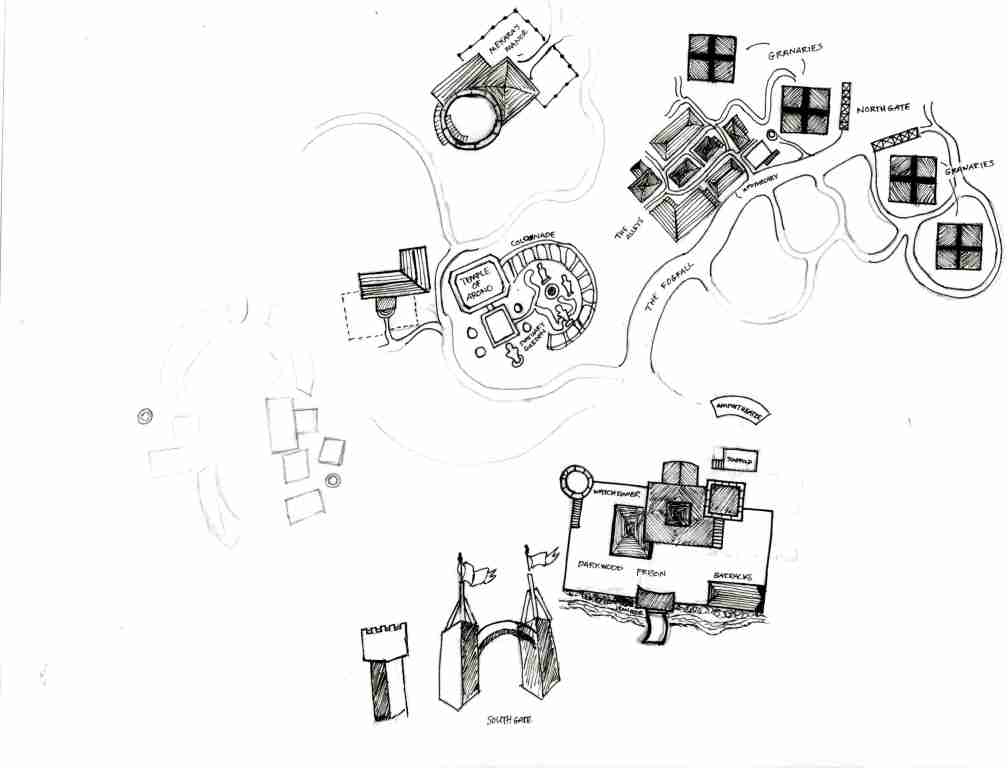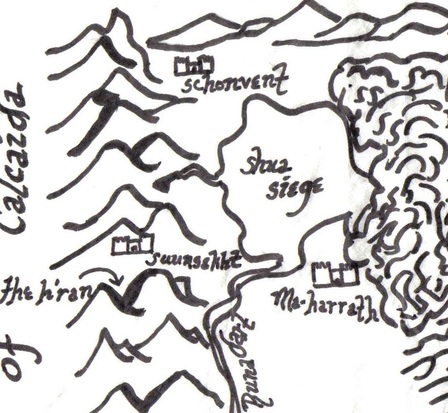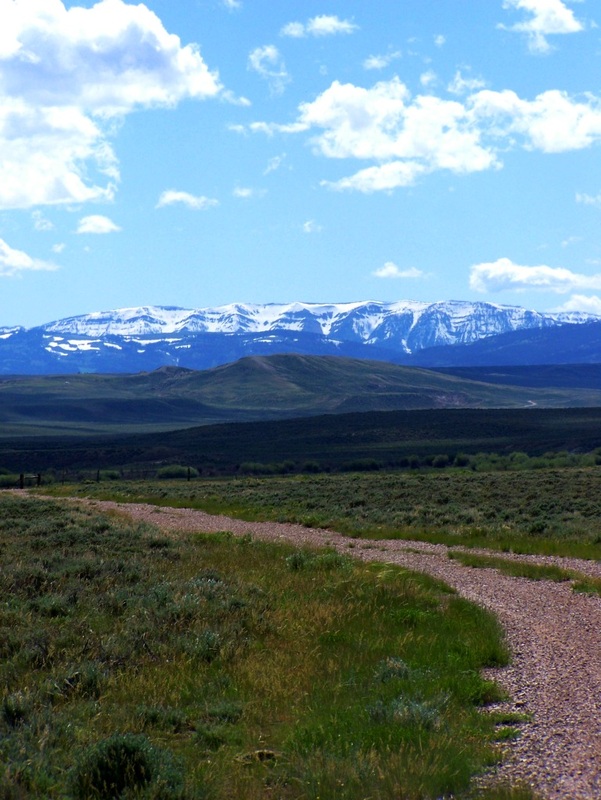The Kingdom of Calcaida
"Land of the Free People"
Lins en Halathi-anyalles:
|
|
Halathi-Geth: The King's CityHalathi-Geth is the capital of Calcaida, the foremost of the three Royal Cities of the kingdom. As the political center of Calcaida, the premier families that live there-- the Dalmōrs, the Whiteclovers and the Greygils-- are rich, ruthless and hungry for power. From their citadels, they attempt to control the king like a piece on a chessboard.
|
from Book Two of the Arqiyyon:
|
Renatha-Geth: The Queen's CityA city under construction.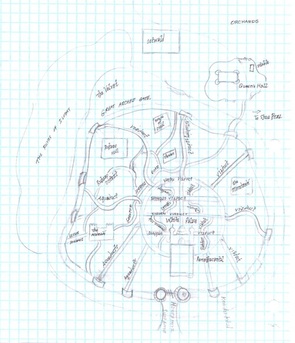
First, I begin with a piece of grid-lined paper and a regular No. 2 pencil. It takes many tries to get the concept right. The illustrated photo is the third evolution of my original vision. Renatha-Geth is a city of opulence, a fitting abode for families such as the Andradi, who are renowned for their wealth and their cruelty. The Renathacantal, the queen's palace and adorning pool, is based on both the Aguedal and the Menara Gardens in Marrakech, Morocco. It is also similar in structure to the Taj Mahal. Its design is meant to mirror the style of the "Exotic Lands" of Jaheirae's cities of Carribide, Breria and Arom, all located on the Thal-en-Saenja, Sea of the Dragon.
|
The drawing above is the as-yet-unfinished version of Renatha-Geth. It is traced from the grid-lined paper onto onionskin paper, my preferred medium for the cartography of the fantastic.
|
Hinrathi-Geth: The Prince's City
Bordelach on the Rôn PlainsThe home of Duke Sulamon the Cripple, King Anrahir's younger brother, was once the home-in-exile of Ardon the Leper and the murderous Scarlet Queen. Its proximity to the Hostile Plains of the Fon S'ul gives it a grey and sinister air that seems to match Sula's perspective on his brother's kingdom.
|
Excerpt from the Arqiyyon:from "The Covenant" Things were not going well. A silver fog ensnared the fortress from the earliest light all through the heat of the afternoon. From the surrounding countryside, the calls of jackdaws and mourning doves filled Sulamon's bedchamber with an eerie sense of desolation...
Through the mist, the torches of the Castle Bordelach diffused and gleamed. Sulamon’s inner chamber was dimly lit. The walls of the chamber had been recently frescoed, their final layer having been applied only days before. The central image in this painting was his black stallion, Darheim, the handsomest of all the horses in Calcaida. On the back of the horse, a falcon upon his arm, sat the Duke himself, a very good likeness. Around Darheim’s prancing feet, the Duke’s favored hounds sniffed through the painted forest in thick pursuit of a painted fox. A heavy bedstead stood opposite the window. The Duke’s study—a bookshelf and a heavy desk, strewn about with papers on matters of state that his brother had thought too insignificant to attend to—occupied the left-hand wall and a washbasin and mirror saluted from the right-hand facing upward in such a way that Sulamon caught sight of his damp forehead and growing pallor... |
Arnō Urmainen Speaks of Itreya
From Volume I of the Arqiyyon
Not long before I returned there, I had dreamed of Itreya. It was Itreya as I had left it, at the height of spring, its yellowcrown spilling over the hillocks, its placid cows working grass between their wide, dull teeth. The jackdaws chirped in the distance, their caws so much gentler than crows. I have seen as much as I care to see of the laughing, ink-black ravens. The wooden fence I had lovingly built, from laths of my own timber. Its crossties, I had secured with rope, and painted with Black Hills tar. The furrows I had ploughed myself, before the drought that shriveled the wheat and the tobacco. Though the stalks are dry and brittle, I persist in seeing the golden sun, sifting light through the greening leaves. Though they had for a time lain fallow, when I left, the furrows were still visible, the fields striated with blacks and browns in alternating light and shadow. This was how my mind remembered Itreya. To describe it as it once was is the only way I can explain the cry that heaved up through my guts when I saw again my beloved farm and beheld its sprawling ruin.
From Volume I of the Arqiyyon
Not long before I returned there, I had dreamed of Itreya. It was Itreya as I had left it, at the height of spring, its yellowcrown spilling over the hillocks, its placid cows working grass between their wide, dull teeth. The jackdaws chirped in the distance, their caws so much gentler than crows. I have seen as much as I care to see of the laughing, ink-black ravens. The wooden fence I had lovingly built, from laths of my own timber. Its crossties, I had secured with rope, and painted with Black Hills tar. The furrows I had ploughed myself, before the drought that shriveled the wheat and the tobacco. Though the stalks are dry and brittle, I persist in seeing the golden sun, sifting light through the greening leaves. Though they had for a time lain fallow, when I left, the furrows were still visible, the fields striated with blacks and browns in alternating light and shadow. This was how my mind remembered Itreya. To describe it as it once was is the only way I can explain the cry that heaved up through my guts when I saw again my beloved farm and beheld its sprawling ruin.
Teirnlance: The City of Crows
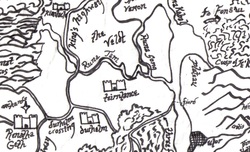
In Teirnlance, a network of streets surround the structures which so obviously pre-date them. The houses and shops sprang up first, and the roads were carved around them by streams of endless foot traffic. One could say the avenues laid themselves down. Over time, the residents trampled new roads between the old roads, seeking the fastest way to arrive at the temple or the lumberyard or the brothel. Thus, the roads have no corners. After a time, this untraveled space clothed itself with dust and grass, strewing itself with thrift and yellowcrown. Residents wander these streets displaying vegetables in baskets woven of riverweed or selling bread from handcarts. Booksellers arrange their titles under colorful awnings while cobblers and whores alike ply their trades in the alleys and in dim and dusty hovels.
In the sky above Teirnlance rests a second city. Its houses are the branches of trees and the thatched rooves of cottages. Its public parks are situated atop Teirnlance’s buildings of industry: the taverns, the granaries, the smithies. In this second city, the public baths are recesses gathering rainwater upon the high, stone parapets of the citadels of the first city. This first city belongs to the people of Teirnlance. The second city belongs to the crows.
In the sky above Teirnlance rests a second city. Its houses are the branches of trees and the thatched rooves of cottages. Its public parks are situated atop Teirnlance’s buildings of industry: the taverns, the granaries, the smithies. In this second city, the public baths are recesses gathering rainwater upon the high, stone parapets of the citadels of the first city. This first city belongs to the people of Teirnlance. The second city belongs to the crows.
|
Situated on the Veldt, the lush plain nurtured by the Runa Tam, Teirnlance is the agricultural center of Calcaida. Its green and brown patchwork of fields and farms can be seen from atop the city's four tallest features: the north-facing Granaries. Chief among Teirnlance's exports is the turnip, giving the city the moniker of "Turnip Town." The farmers who live just outside the city also grow an abundance of cotton, potatoes, melons, squash, tobacco and corn. Much of this food is exported to Calcaida's major cities: Halathi Geth, Renatha-Geth and Hinrathi-Geth. Tree farms (usually miglan and white oak) allow the growth and export of quality wood for the building of houses and furniture. The presence of a large mill on the city's eastern border aids in the production and carving of furniture for export and trade lending the area the name of Treefall. Some of the kingdom's best woodworkers originated in this neighborhood of the City of Crows.
|
|
These rich nobles of Teirnlance, mostly Tirma who have purchased titles from the crown, reside in grand, wooden manors clustered near the mill, in the eastern quarter of the city. Merchants and their fine houses dominate the west quarter, called Tradefair, while the slums span the south quarter, near the macabre facade of Darkwood Prison. The granaries and their dependent businesses lie to the north. In the center of the city sprawls the Temple of Arono, the monument dedicated to the goddess of the harvest, Teirnlance's primary deity. The Fogfall, the city's main thoroughfare, begins at Northgate and terminates at Tradefair Square after bypassing Southbridge and Southgate. This road runs directly past Darkwood Prison, Teirnlance's most imposing structure. Near the prison huddle slumhouses in a section of town called the Tannery for its abundance of tanners and the rancid smells that accompany them.
|
The city is criss-crossed by two small "rivers." In the south, Greywater spans from the Havora to the Huador. Neither body of water is large enough for a lake, but many of the city's richest citizens live surrounding the Havora. The Huador holds the runoff from the tanneries and butcher shops in the Darkwood Slums. In the north end lies the Dubreti, a spring that originates at the Tam and terminates at the pond spanned by the Alleys Bridge.
